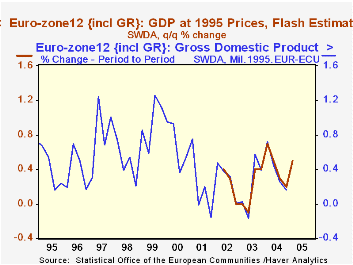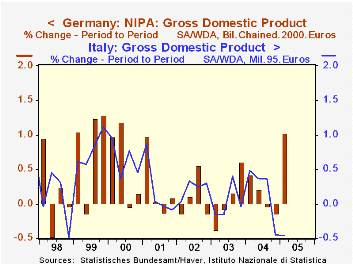 Global| May 12 2005
Global| May 12 2005German Q1 Growth of 1% Boosts Euro-Zone Result to 0.5%
Summary
The Euro-Zone had 0.5% GDP growth in Q1, according to the Eurostat "Flash" estimate released today. This produced a year-on-year result of 1.4%, moderately weaker than any quarter since Q4 2003. In these early "Flash" figures, no [...]

The Euro-Zone had 0.5% GDP growth in Q1, according to the Eurostat "Flash" estimate released today. This produced a year-on-year result of 1.4%, moderately weaker than any quarter since Q4 2003. In these early "Flash" figures, no details are available by type of expenditure or industry, so there's no way to tell what factors contributed to the performance.
We do, however, know something about where the developments took place. Germany experienced a nice rebound, reaching 1.0% after two quarters of virtually no growth at all. Among other Euro-Zone countries, they join the UK with its 0.6% gain in boosting Europe's economy.
Elsewhere, results were not so attractive. Italy lost 0.5% and the Netherlands, 0.1%; Belgian GDP was unchanged. Both Italy and the Netherlands GDP also decreased year-on-year.
The Netherlands reported its expenditure breakdown; private consumption edged slightly lower, and investment contracted more sharply after a good gain in Q4. Net exports decreased. The only positive input came in inventories, which grew €327 million compared to €192 million in Q4.
These data are mixed now by calculation methodology. As noted in the table below, "real" GDP for the overall Euro-Zone remains expressed in fixed-weights and 1995 prices; Italy's own data are also still on this basis. Germany, the UK and the Netherlands have all switched to annual chain-weighting, but Germany's reference year is 2000, the Netherlands, 1995 and the UK, 2001. Euro-Zone conventions call for all countries to switch to chain-linking by late 2006. There are also differences in the treatment of imputed charges for financial services, so-called "FISIM". These are to be reconciled for the most part by the end of this year, with a few countries in 2006. Consumption and net exports will be affected.
| GDP % Changes | 1 Qtr 2005 | 4 Qtr 2004 | Year/ Year | 2004 | 2003 | 2002 |
|---|---|---|---|---|---|---|
| Euro-Zone (fixed 1995€) | 0.5 | 0.2 | 1.4 | 1.8 | 0.5 | 0.9 |
| Germany (chain 2000€) | 1.0 | -0.1 | 0.0 | 1.6 | 0.0 | 0.2 |
| Italy (fixed 1995 €) | -0.5 | -0.4 | -0.2 | 1.0 | 0.4 | 0.4 |
| Netherlands (chain 1995€) | -0.1 | -0.0 | -0.3 | 1.4 | -0.9 | 0.6 |
Carol Stone, CBE
AuthorMore in Author Profile »Carol Stone, CBE came to Haver Analytics in 2003 following more than 35 years as a financial market economist at major Wall Street financial institutions, most especially Merrill Lynch and Nomura Securities. She had broad experience in analysis and forecasting of flow-of-funds accounts, the federal budget and Federal Reserve operations. At Nomura Securities, among other duties, she developed various indicator forecasting tools and edited a daily global publication produced in London and New York for readers in Tokyo. At Haver Analytics, Carol was a member of the Research Department, aiding database managers with research and documentation efforts, as well as posting commentary on select economic reports. In addition, she conducted Ways-of-the-World, a blog on economic issues for an Episcopal-Church-affiliated website, The Geranium Farm. During her career, Carol served as an officer of the Money Marketeers and the Downtown Economists Club. She had a PhD from NYU's Stern School of Business. She lived in Brooklyn, New York, and had a weekend home on Long Island.





